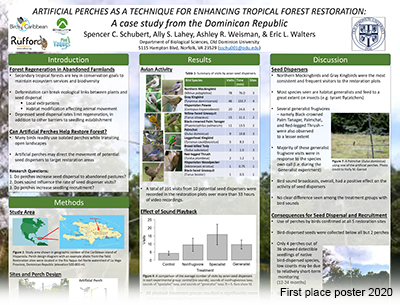ORCID
0000-0002-9414-5758 (Walters)
College
College of Sciences
Program
Ph.D. Ecological Sciences - Biological Sciences
Publication Date
Spring 2020
DOI
10.25883/0b1e-v235
Abstract
Recovering secondary forests on degraded agricultural lands represents a promising opportunity to offset global carbon emissions as well as increasing local biodiversity and ecosystem services. In the insular tropical forests of the Caribbean, frugivorous birds are the primary seed dispersers for most native woody plants and have a large influence on regeneration dynamics during forest succession. In 2017, we initiated an experimental forest restoration program incorporating artificial perches on private farms within the Rio Yaque del Norte watershed in La Vega province, Dominican Republic. Five restoration plots (0.15–0.25 ha) were constructed in pastures near deforested streams. In each plot, 6-12 artificial perches, each 5 m in height, were constructed from bamboo poles fitted with crossbars. We remotely monitored perch use by birds using video cameras and evaluated the effects of perches on the establishment of woody plants in seedling quadrats both below perches and in open spaces. During the summer of 2019, we conducted a behavioral experiment using audio broadcasts of bird sound to test the effect of different avian taxa and feeding guilds on attracting seed dispersers. Eleven avian species were recorded visiting perches, with the most common being Northern Mockingbird and Gray Kingbird. Broadcasting bird sounds led to a significantly greater number of avian visits to the plot. We documented 1,171 seeds from 31 distinguishable species collected from seed traps below perches during the study. Most seedling regeneration in our plots was from exotic non-bird-dispersed taxa which grew equally in perches and control quadrats. Native plant seedlings were infrequent (i.e. beneath 4 of 36 perches) but grew exclusively beneath perches. We conclude that artificial perches are an effective method for augmenting the natural seed bank but are likely to be most effective when used in tandem with planting trees that readily grow to produce shade and litter.
Keywords
Artificial perches, Tropical forest restoration, Avian taxa, Dominican Republic
Disciplines
Biodiversity | Ecology and Evolutionary Biology | Forest Management | Ornithology
Files
Download Full Text (981 KB)
Recommended Citation
Schubert, Spencer; Lahey, Ally S.; Weisman, Ashley R.; and Walters, Eric L., "Artificial Perches as a Technique for Enhancing Tropical Forest Restoration: A Case Study From the Dominican Republic" (2020). College of Sciences Posters. 5.
https://digitalcommons.odu.edu/gradposters2020_sciences/5

Included in
Biodiversity Commons, Ecology and Evolutionary Biology Commons, Forest Management Commons, Ornithology Commons


